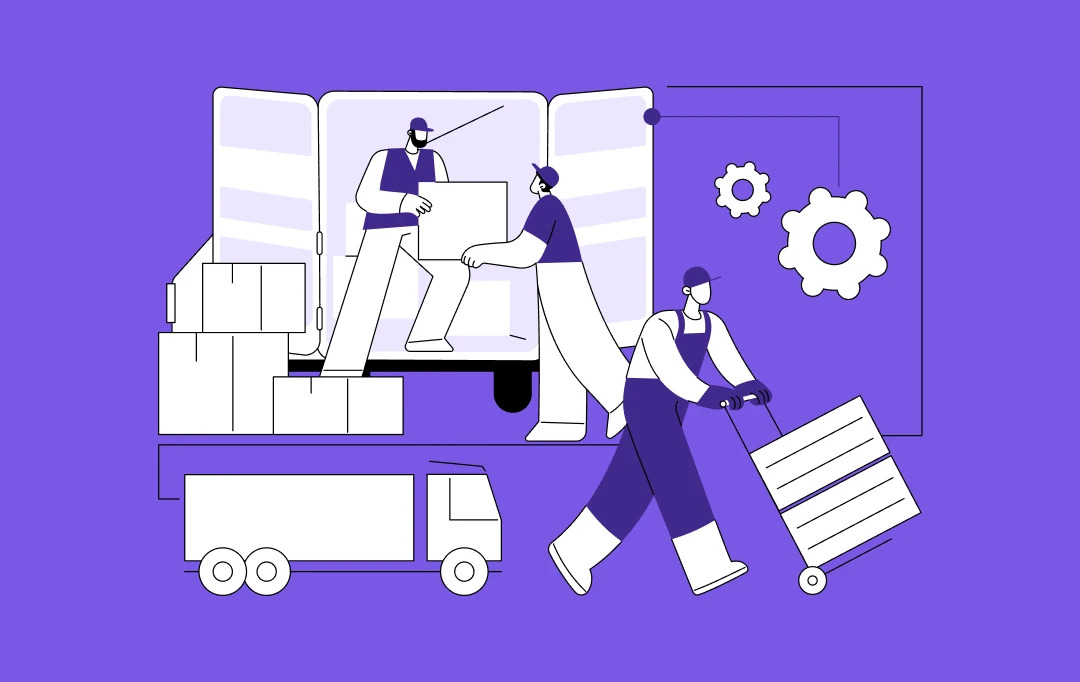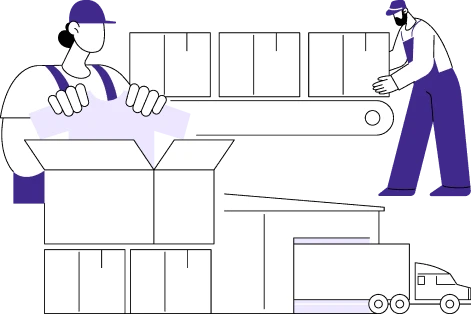- Understanding the Australian eCommerce Landscape in 2025
- Why Scalable eCommerce Logistics for Australian Businesses Matters to Support Global Growth
- Pain Points in Scaling eCommerce Logistics for Global Markets
- Pressure to Meet Customer Expectations for Fast Delivery
- Cross-Border Headaches
- Speed, Cost, and Green Goals
- Infrastructure That Falls Short
- Inventory Management Woes
- Supply Chain Surprises
- Key Components of a Scalable eCommerce Logistics Strategy
- Multi-Modal Transportation Network Design
- Warehouse and Fulfillment Center Placement
- Technology Integration and Automation
- Carrier Relationship Management
- Technological Innovations Enabling Scalable Logistics
- Artificial Intelligence and Machine Learning in Demand Forecasting
- The Role of Automation and Robotics in Warehouse Operations
- Blockchain for Secure and Transparent Transactions
- Cloud-Based Platforms for Integrated Logistics Management
- Internet of Things (IoT) in Tracking and Monitoring Shipments
- Steps by Step Process for Australian Businesses to Get Started
- 1. Assess Your Current Capabilities and Goals
- 2. Research Target Markets and Compliance
- 3. Choose Your Fulfillment Model
- 4. Select International Shipping Partners
- 5. Implement Technology for Integration and Visibility
- 6. Design a Returns Management Process
- 7. Pilot, Learn, and Optimize
- Key Considerations for Australian Businesses Going Global
- How to Avoid Common Pitfalls When Scaling Your Logistics
- Over-Engineering Early Solutions
- Underestimating International Complexity
- Neglecting Returns Management
- How Appinventiv Can Help Build Your Scalable eCommerce Logistics Strategy
- FAQs
Key takeaways:
- To thrive internationally, a scalable eCommerce logistics strategy for Australian businesses is indispensable.
- AI, blockchain, and IoT enable precise demand forecasting, streamline operations, and provide full transparency.
- You can overcome rising costs and limitations by focusing on decentralized warehousing, optimized inventory, and eCommerce shipping integration.
- Building strong ties with domestic and international logistics partners is vital for reducing risks and ensuring smooth, cost-effective global operations.
The Australian eCommerce market is experiencing remarkable growth, with online spending reaching a record $69 billion in 2024 – a 12% year-over-year increase. Yet behind every successful digital storefront lies a complex web of logistics operations that can make or break global expansion dreams.
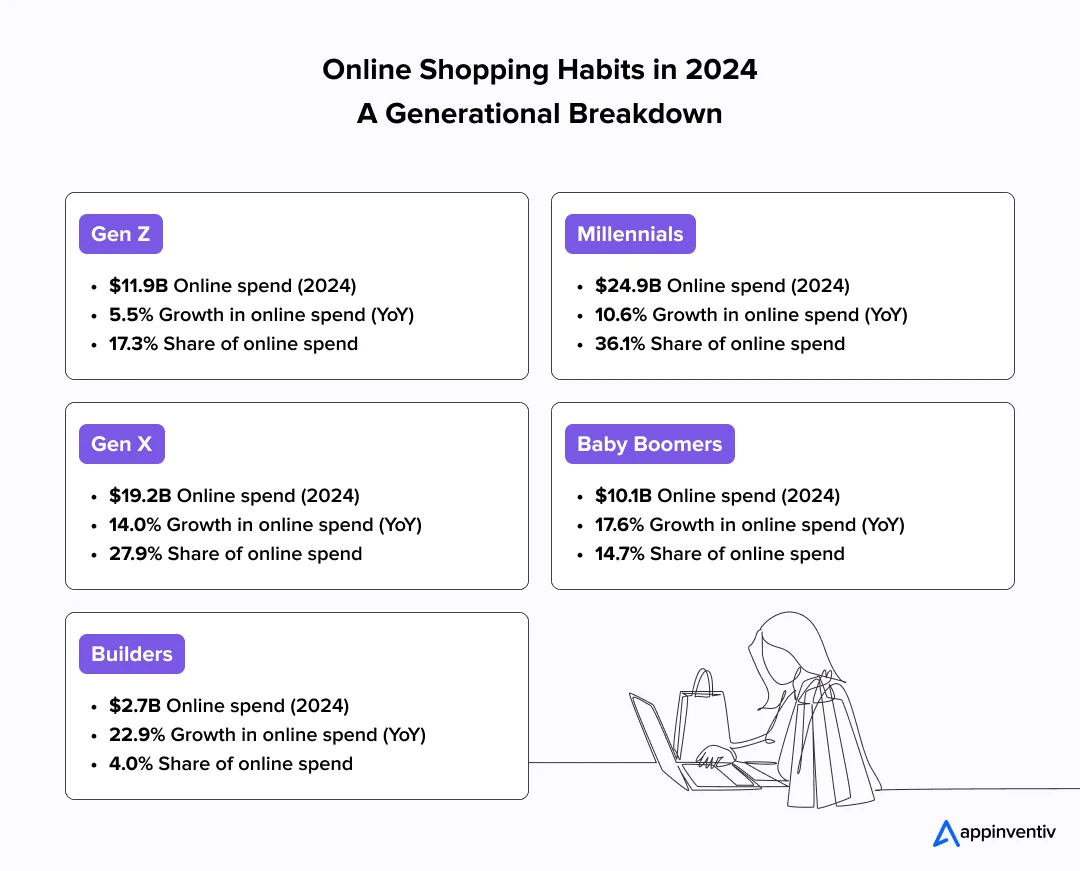
Consider Catch Group’s transformation from a daily deals site to one of Australia’s largest online marketplaces. Their secret? A meticulously crafted eCommerce logistics strategy for Australian businesses that enabled them to scale operations dramatically. The company now sells an item every 2.8 seconds and ships over 10,000 orders per day. This demonstrates the power of efficient logistics infrastructure in supporting massive growth.
But Catch’s success story represents the exception, not the rule. For most Australian businesses today, the pressure is intensifying from all directions.
The pressure is intensifying from all directions. Australian consumers now expect Amazon-level delivery speeds, creating unprecedented service demands. At the same time, logistics costs are spiraling upward – 43% of Australian retailers raised their free shipping thresholds in 2023 to combat rising supply chain expenses. Furthermore, Australia Post’s July 2024 rate increases added further strain to already stretched shipping budgets.
Yet amid these challenges, global markets offer tremendous expansion opportunities worth billions of dollars. The businesses that will capitalize on this potential are those building scalable logistics infrastructure today – not tomorrow.
This comprehensive blog reveals how to build a strategy for eCommerce logistics for Australian businesses to support global growth.
Let Appinventiv help you scale your logistics strategy to meet this explosive growth.
Understanding the Australian eCommerce Landscape in 2025
Australia’s online shopping world has grown fast, but it comes with its own set of challenges. Think about it – this country is massive. Getting a package from Sydney to Perth is like shipping something from London all the way to Istanbul. That’s a logistics nightmare waiting to happen.
eCommerce logistics in Australia isn’t just about moving boxes from point A to point B. It’s about dealing with a country where most people live in big cities, but millions still call rural areas home. While most Australians (around 87%) live in urban areas, about 7 million people are scattered across rural and remote regions. These folks often wait longer for deliveries and pay more for shipping.
The game has changed big time. International players like Temu and Shein have stormed in with lightning-fast delivery promises. Now everyone expects their orders to be delivered in a couple of minutes or on the same day. Research shows that convenience drives most online purchases – people want their stuff fast and hassle-free.
As said above, Australian shoppers broke records in 2024, spending $69 billion online. But it’s not spread evenly throughout the year. Think about those crazy shopping periods – end of financial year sales in June and July, then Black Friday madness that seems to stretch from November to January. During these times, order volumes can triple or quadruple overnight, testing logistics infrastructure limits.
Cross-border opportunities abound, particularly within the Asia-Pacific region, where Australia enjoys favorable trade agreements. But here’s the catch – cross-border supply chain eCommerce in Australia means dealing with customs paperwork, different consumer laws in each country, and currency rates that change faster than Melbourne weather.
Why Scalable eCommerce Logistics for Australian Businesses Matters to Support Global Growth
Scaling globally isn’t just about selling more—it’s about delivering efficiently. A scalable eCommerce logistics strategy for Australian businesses ensures you can handle surging order volumes without breaking the bank. Without it, businesses risk operational bottlenecks, unhappy customers, and missed opportunities.
Technology is the game-changer here. From AI-powered demand forecasting to IoT-enabled tracking, tech solutions streamline logistics and eCommerce processes, cut costs, and boost customer trust.
Understanding these landscape challenges and the importance of scalable logistics is one thing, but actually scaling your logistics to handle global growth is a real pain. That’s where most Australian businesses hit their first major roadblock.
Pain Points in Scaling eCommerce Logistics for Global Markets
Every ambitious Australian business dreams of conquering international markets, but the reality of global logistics expansion often becomes a wake-up call. What works perfectly for domestic operations can completely fall apart when dealing with multiple countries, currencies, and customer expectations. The logistics infrastructure that makes you fly high in the domestic sky may fail to expand your wings in the global market.
Here’s where most businesses discover that scaling isn’t just about doing more of the same; it’s about rethinking how you move products around the world. With that said, here are some critical pain points that Australian businesses face when scaling their eCommerce business in the global marketplace:
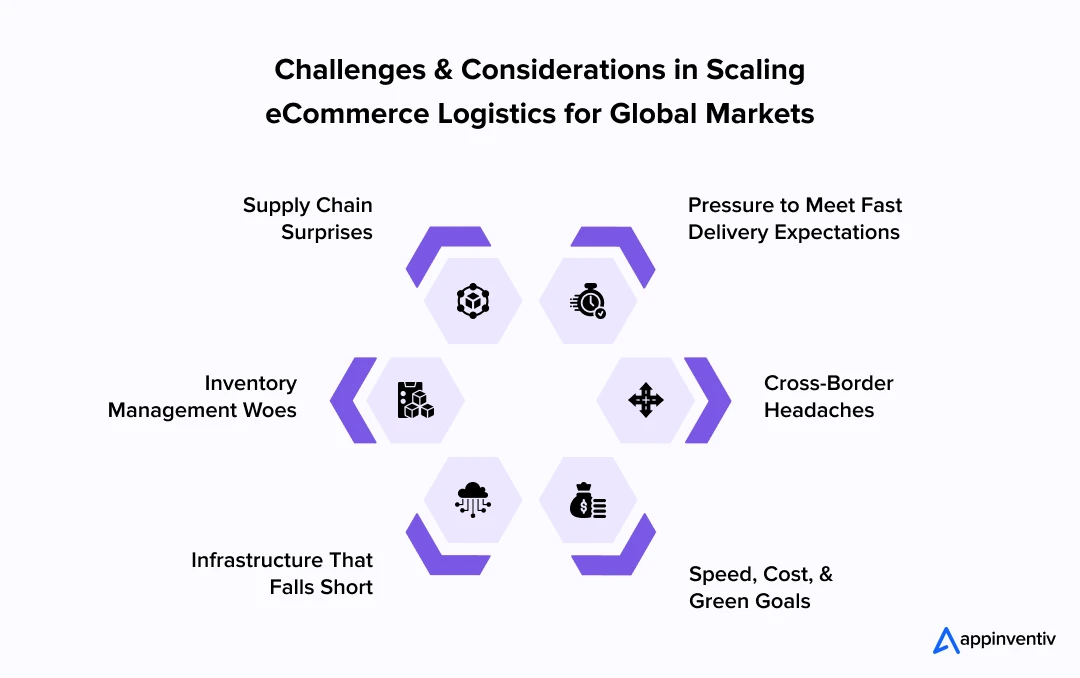
Pressure to Meet Customer Expectations for Fast Delivery
According to Statista, last-mile delivery costs have become the primary profitability killer, accounting for 53% of total shipping expenses. For Australian businesses, it’s a major issue. In cities like Sydney and Melbourne, customers want packages fast—think same-day delivery. But in rural areas, sparse infrastructure drives up costs. eCommerce shipping in Australia struggles to balance speed and affordability. Global players like Shein offer free shipping on cheap orders, putting pressure on local businesses.
What is the quick fix? Smart technology, such as route optimization software, can reduce costs while maintaining quick deliveries.
Cross-Border Headaches
Going global means dealing with customs, tariffs, and trade rules. For instance, Shipping to Asia-Pacific markets involves navigating ASEAN trade agreements, which can delay deliveries by up to 10 days if mishandled. For supply chain eCommerce in Australia, these rules are a big challenge. Mess up the paperwork, and your goods are stuck, costing you time and money.
What is the quick fix? Partnering with logistics experts or utilizing technology like blockchain can help keep things moving smoothly.
Speed, Cost, and Green Goals
Customers want fast delivery, low prices, and eco-friendly practices. As new research reveals, 2 in 3 (68%) Aussie shoppers choose brands with green shipping. However, many of the Australian businesses find it hard to go green without raising costs. Furthermore, eCommerce giants like Amazon offer same-day delivery, pushing local businesses to keep up while staying affordable.
What is the quick fix? Using recyclable packaging or electric vans can help balance speed, cost, and sustainability in the logistics eCommerce space.
Infrastructure That Falls Short
Australia’s logistics setup isn’t ready for eCommerce’s small, frequent orders. Many warehouses lack automation, so peak seasons like Black Friday turn into chaos. Scaling eCommerce logistics in Australia is tough when your systems can’t handle demand spikes.
What is the quick fix? Automation, like robotic picking, can make warehouses more efficient, saving time and money.
Inventory Management Woes
Keeping stock balanced across multiple markets is a challenge. Like any other eCommerce business in the world, Australian eCommerce businesses also face stockouts and overstock mess-ups due to poor inventory tracking. This not only hurts profits but also erodes customer trust.
What is the quick fix? Cloud platforms and AI can provide clear visibility, ensuring your supply chain eCommerce in Australia stays on track.
Supply Chain Surprises
Global disruptions like port strikes, trade issues, natural disasters, and unforeseen global crises (like pandemics) can cripple traditional supply chains. Imagine your top product stuck during peak season. Australian businesses, often at the end of long supply lines, are particularly vulnerable to these disruptions.
What is the quick fix? A strong eCommerce logistics strategy for Australian businesses needs backup plans, like multiple suppliers or regional hubs, to stay resilient.
Key Components of a Scalable eCommerce Logistics Strategy
Building a truly scalable logistics foundation requires strategic thinking across six critical dimensions. Each component must work harmoniously to create a system that grows efficiently with business expansion.
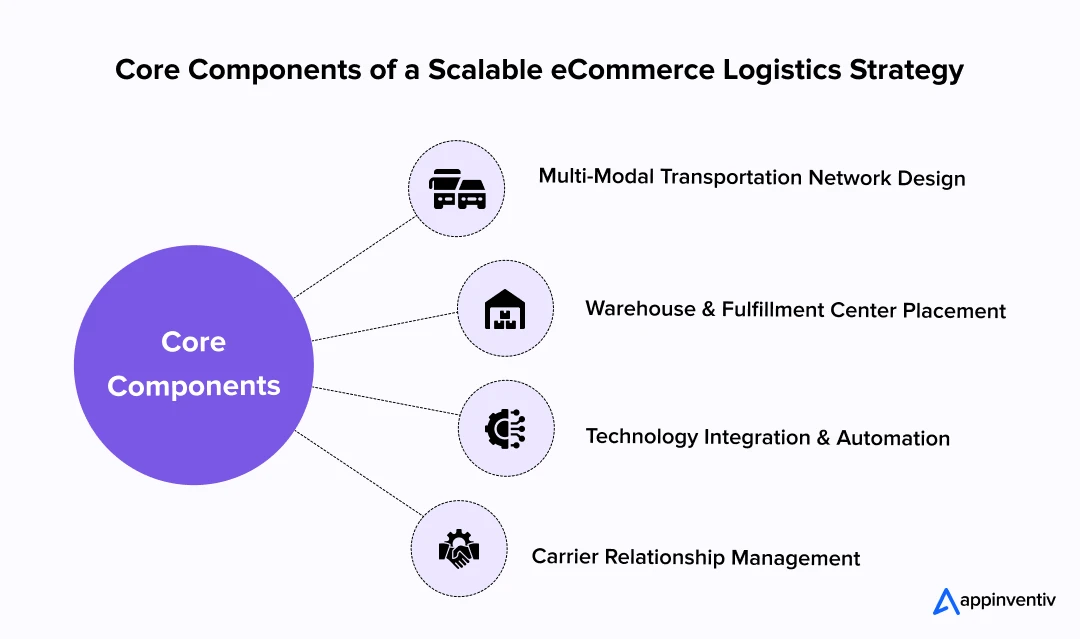
Multi-Modal Transportation Network Design
A successful logistics strategy for eCommerce begins with transportation network optimization. This involves combining air freight, sea shipping, road transport, and rail connections to minimize costs while maintaining service levels.
Leading Australian businesses utilize hub-and-spoke models centered on major airports and ports. Melbourne’s Tullamarine and Sydney’s Kingsford Smith serve as primary international gateways, while regional hubs in Brisbane, Perth, and Adelaide handle domestic distribution.
Smart network design considers transit times, capacity constraints, and cost structures across all modes. Sea freight offers cost advantages for non-urgent shipments, while air freight enables premium delivery services. The key lies in matching transportation modes to customer service commitments and margin requirements.
Warehouse and Fulfillment Center Placement
Location strategy can make or break logistics efficiency. Proximity to major population centers reduces last-mile costs. At the same time, access to transportation infrastructure enables efficient inbound and outbound flows.
Data-driven site selection considers multiple factors: population density within delivery zones, real estate costs, labor availability, and regulatory environment. Brisbane’s growing logistics precinct offers compelling advantages with lower real estate costs and improved infrastructure connections.
eCommerce shipping integration requires warehouses designed for omnichannel operations. Modern fulfillment centers must handle both B2C and B2B orders, process returns efficiently, and integrate with multiple carrier networks.
Technology Integration and Automation
Warehouse automation has gone far beyond simple conveyor belts. Today, it includes smart robots, AI-driven optimization, and systems that predict maintenance needs. These technologies cut labor costs while improving accuracy and throughput.
Automated sorting systems can process around 12,000+ items per hour with 99.9% accuracy. This level of efficiency dramatically reduces the manual labor required for order fulfillment. However, automation requires significant capital investment, so it might not be suitable for smaller operations.
Cloud-based warehouse management systems (WMS) offer real-time visibility across all locations and integrate with carriers, online marketplaces, and accounting systems. This technological foundation is essential for managing complex operations across multiple markets and is a crucial part of eCommerce logistics. (Details later in the section below).
Carrier Relationship Management
Strategic carrier partnerships provide competitive advantages that pure transactional relationships cannot deliver. Volume commitments enable negotiated rates, priority capacity allocation, and service level guarantees.
Diversified carrier networks reduce risk while providing service options across different customer segments. Premium carriers handle time-sensitive shipments, while economy options serve price-sensitive customers.
For successful eCommerce shipping in Australia, it’s vital to understand each carrier’s strengths. Australia Post is excellent for residential deliveries, while private carriers like StarTrack and TNT often provide better service for commercial deliveries.
Technological Innovations Enabling Scalable Logistics
Optimizing eCommerce logistics for Australian businesses increasingly depends on advanced technology. These are truly essential eCommerce logistics trends that support global growth with unamteched efficiency.
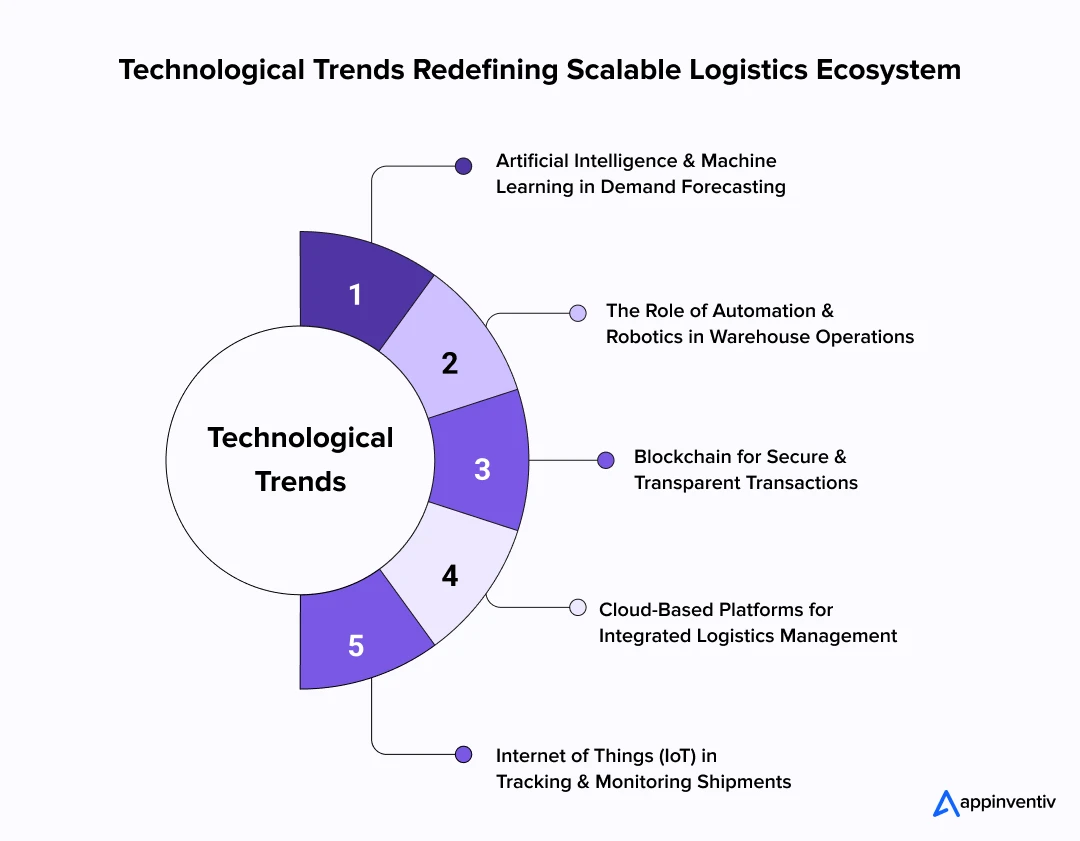
Artificial Intelligence and Machine Learning in Demand Forecasting
Machine Learning (ML) and Artificial Intelligence (AI) facilitate precise demand forecasting. These technologies analyze vast datasets, including past sales, seasonal trends, and marketing campaign performance. This analysis leads to more accurate predictions of future demand. This predictive capacity helps optimize inventory levels, effectively preventing both stockout and overstock situations.
Also Read: AI in Australia: Implementation, Opportunities, and More
The Role of Automation and Robotics in Warehouse Operations
Automation and robotics are exponentially altering warehouse operations. They use intelligent systems for picking, packing, and sorting items. These technologies lower labor expenses and enhance accuracy and processing speed. While implementing automation and robotic capabilities requires a surplus investment initially, they just improve operational efficiency multiple times, ensuring quicker, more accurate order fulfillment.
Blockchain for Secure and Transparent Transactions
We all know that Blockchain is the new name of security and transparency. Blockchain in the supply chain establishes an immutable, distributed digital ledger that records every transaction and product movement. This capability helps reduce fraud, improve traceability, and erode trust among supply chain collaborators. Although the implementation of blockchain in logistics is still in an initial phase, it offers notable visibility and security for logistics eCommerce.
Cloud-Based Platforms for Integrated Logistics Management
Cloud-based platforms consolidate distinct logistics systems, enabling seamless data exchange. They offer a unified perspective of inventory, shipments, and orders across global operations. This facilitates real-time communication between eCommerce platforms, warehouse management systems, and shipping partners. This eCommerce shipping integration through cloud technology results in smoother, faster, and more adaptable operations. Not to mention, easy accessibility to vital information from anywhere, anytime, is critical for timely decision-making.
Internet of Things (IoT) in Tracking and Monitoring Shipments
IoT devices – sensors embedded in packages, vehicles, or warehouse equipment – provide real-time data on location, temperature, humidity, and even shock. This granular visibility enhances supply chain transparency and allows for proactive intervention if issues arise.
Also Read: Everything to know about IoT in supply chain and logistics
Steps by Step Process for Australian Businesses to Get Started
Building a scalable eCommerce logistics for Australian businesses is complex and challenging. It requires a structured approach and careful consideration of multiple aspects. Here is a step-by-step process to guide your Australian eCommerce & logistics efforts, ensuring a measured and effective expansion.
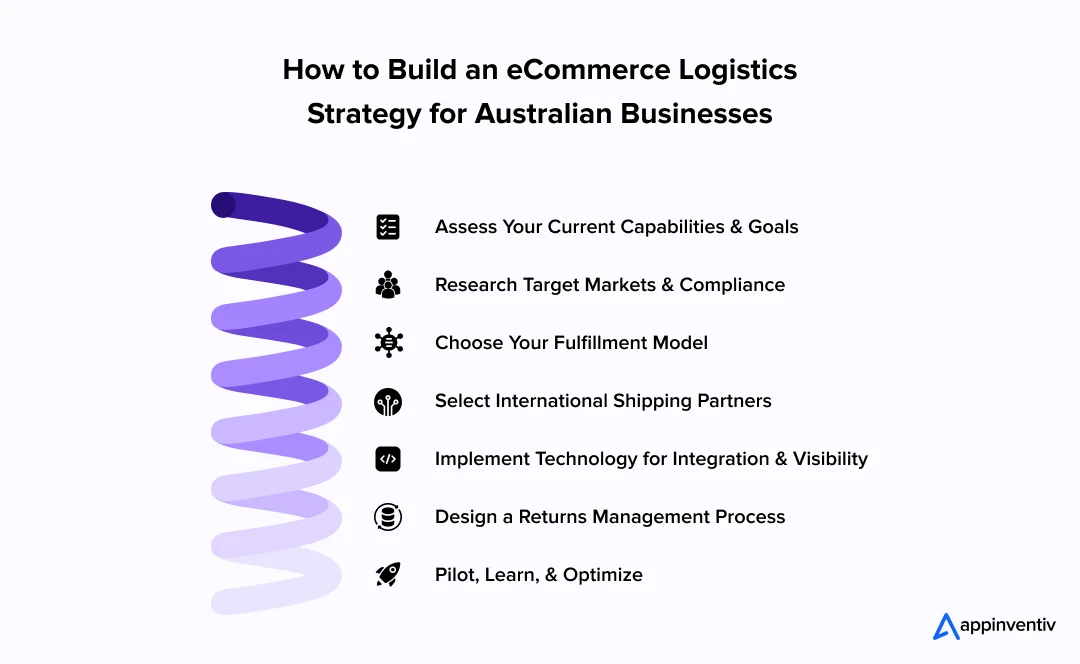
1. Assess Your Current Capabilities and Goals
Before looking outward, understand your existing internal logistics. Evaluate your current inventory management, packaging, and domestic shipping processes. Clearly define your global aspirations: which markets are you targeting first? What volume of international sales do you anticipate?
Outcome: This initial assessment provides a baseline for developing a scalable eCommerce logistics strategy for Australian businesses.
2. Research Target Markets and Compliance
Each international market has unique requirements. Thus, you must investigate import regulations, customs duties, taxes, and product certifications for your chosen target countries. Understand local consumer preferences for delivery speed, payment methods, and return policies.
Outcome: This research is crucial to navigate potential logistics/shipping challenges in Australia when expanding abroad.
3. Choose Your Fulfillment Model
Decide how you will store and ship products to international customers. Options range from maintaining all inventory in Australia and shipping directly to partnering with Third-Party Logistics (3PL) providers with global fulfillment networks. A 3PL can handle warehousing, picking, packing, and even some customs processes in the destination country, significantly streamlining eCommerce logistics. Consider a hybrid model where domestic fulfillment remains in-house, but international fulfillment is outsourced.
Outcome: This decision streamlines eCommerce logistics by optimizing where and how inventory is managed for international sales.
4. Select International Shipping Partners
Identify carriers and freight forwarders with strong international networks and experience with eCommerce shipping in Australia to your target markets. Compare their rates, transit times, tracking capabilities, and expertise in customs clearance. A multi-carrier strategy often offers flexibility and cost efficiency. Ensure that your chosen partners can integrate with your existing systems to facilitate seamless order flow and tracking.
Outcome: A multi-carrier approach offers flexibility and cost efficiency, ensuring a smooth order flow and tracking through system integration.
5. Implement Technology for Integration and Visibility
Technology is the backbone of scalable eCommerce logistics. Implement or upgrade your Warehouse Management System (WMS) and Transportation Management System (TMS). Crucially, ensure strong eCommerce shipping integration between your online store platform, WMS, TMS, and carrier systems.
Outcome: This provides real-time visibility into inventory levels, order status, and shipment tracking, which is essential for managing a global operation from Australia.
6. Design a Returns Management Process
Returns are an inevitable part of eCommerce. Thus, you must craft a clear, customer-friendly international returns policy. Work with your logistics partners to set up efficient reverse logistics processes for managing returned goods from international markets. This might involve local return points or consolidated return shipments back to Australia.
Outcome: A streamlined returns process enhances customer satisfaction and reduces potential losses.
7. Pilot, Learn, and Optimize
Start with a pilot program in one or two key international markets to test your logistics strategy for eCommerce. Monitor key performance indicators (KPIs) such as delivery times, shipping costs, return rates, and customer feedback. Use this data to identify bottlenecks and areas for improvement.
Outcome: Logistics is an iterative process; continuous analysis and optimization ensure sustained global growth.
Also Read: Building a Logistics Management System: The Why’s and How’s
Now that you know how to build a successful, scalable logistics strategy for eCommerce, here are some key considerations and eCommerce shipping best Practices in Australia:
Key Considerations for Australian Businesses Going Global
Expanding globally demands more than just efficient shipping. It requires a deep understanding of market nuances, regulatory compliance, and a commitment to localization. With that said, here are some key considerable steps to eCommerce shipping in Australia:
- Customs Duties, Taxes, and Trade Agreements: Each country has specific tariffs, duties, and taxes that apply to the cost of imported goods. Australian businesses must understand the factors affecting eCommerce shipping and logistics costs to avoid unexpected charges for customers. Leveraging free trade agreements (FTAs) can offer significant advantages.
- Product Compliance and Certification: Products must meet the safety, environmental, and quality standards of the target market. This often requires specific certifications or modifications. Failure to comply can lead to seized goods, fines, or reputational damage.
- Data Privacy and Security (e.g., GDPR, Local Regulations): When handling crucial customer data across international borders, you must adhere to various data privacy regulations, such as GDPR and local Australian privacy laws.
- Multi-currency and Local Payment Options: Offering prices in local currencies and supporting preferred local payment methods (e.g., digital wallets, UPI transactions, or bank transfers) can reduce cart abandonment rates.
- Multi-Lingual and Localized Customer Communication: Providing customer support in local languages and being aware of cultural communication norms builds trust. Proactive communication about shipping status, in the customer’s language, is also highly valued.
- Transparent Shipping Costs and Delivery Expectations: Hidden fees or unclear delivery timelines are major deterrents. Therefore, you must communicate all hidden shipping costs, duties, and estimated delivery times upfront.
Appinventiv’s team of tech experts can design a tailored logistics strategy that integrates seamlessly with your eCommerce platform.
How to Avoid Common Pitfalls When Scaling Your Logistics
Scaling eCommerce logistics for Australian businesses for global reach presents unique challenges. Avoiding common pitfalls is crucial to ensure smooth operations and sustained growth. Here’s how you can overcome potential obstacles effectively.
Over-Engineering Early Solutions
Challenge: Many businesses invest in complex automation and advanced systems before establishing stable, efficient manual processes. This approach often creates expensive solutions that don’t address fundamental operational issues.
Solution: Start with process optimization before adding technology complexity. Document workflows, eliminate waste, and establish quality controls using manual methods. Technology should enhance efficient processes, not mask inefficient ones.
Focus on systems that grow with the business rather than requiring complete replacement as volumes increase. Modular solutions enable incremental capability additions without disrupting existing operations.
Underestimating International Complexity
Challenge: Cross-border expansion introduces regulatory, cultural, and operational complexities that catch many businesses unprepared. What works domestically often fails internationally without significant adaptation.
Solution: Conduct market research and comprehend consumer preferences and delivery expectations to prevent costly mistakes.
Plan for 2-3x longer implementation timelines for international expansion compared to domestic growth. Regulatory approvals, partner onboarding, and system integration take longer in unfamiliar markets.
Neglecting Returns Management
Challenge: Returns processing can consume around 15-25% of logistics capacity while generating negative margins if not managed efficiently. Many businesses focus on outbound logistics while treating returns as an afterthought.
Solution: Design returns processes from the beginning rather than retrofitting existing systems. Efficient returns handling can become a competitive advantage through improved customer experience.
Consider returns logistics when selecting fulfillment locations and technology systems. Some locations offer better access to refurbishment services or secondary markets for returned inventory.
How Appinventiv Can Help Build Your Scalable eCommerce Logistics Strategy
At Appinventiv, we understand that logistics software development services form the technological backbone of successful global expansion. Our skilled team of 1600+ tech experts has helped over 300 businesses transform their logistics operations through custom software development that scales with growth.
Our comprehensive approach addresses every aspect of logistics transformation.
- Our tech consultants closely connect with you to understand your challenges, crafting a logistics technology roadmap that aligns with your global goals.
- We design and develop warehouse management systems optimized for multi-channel operations.
- We implement an AI-powered demand forecasting system to reduce inventory costs while improving customer satisfaction.
- Our expertise ensures smooth eCommerce shipping integration across carriers, marketplaces, and your core business systems.
- We use an iterative approach to continually refine your logistics strategy for eCommerce based on real-world performance data.
- We provide ongoing support and design solutions with inherent scalability to accommodate your global growth for eCommerce logistics in Australia and beyond.
Our custom software developers in Australia have helped businesses reduce logistics costs, improve delivery speeds, and increase customer satisfaction scores.
Partner with Appinventiv to transform your logistics challenges into competitive advantages. Let’s build the scalable eCommerce logistics for Australian businesses that support global growth together.
FAQs
Q. What is eCommerce logistics, and why does it matter in Australia?
A. Think of eCommerce logistics as everything that happens behind the scenes to get your online order from a warehouse to your doorstep. It’s all about storing, managing, and delivering those products. In a huge country like Australia, getting this right is super important. If you want to deliver things quickly and keep costs down, you need really efficient logistics.
Why does it matter so much? Because Australian shoppers expect service levels like Amazon offers. So, businesses here absolutely have to nail their warehouse operations, transportation, and that final leg of delivery to stay competitive. Plus, with our seasonal shopping rushes and chances to sell overseas, having logistics that can grow with your business is just plain essential for long-term success.
Q. What compliance or customs barriers should Australian eCommerce businesses be aware of with respect to logistics or shipping?
A. Australian businesses expanding globally must navigate complex regulatory landscapes. Thai includes customs documentation, product safety certifications, and import/export restrictions.
Key considerations include GST obligations for international sales, Australian Consumer Law compliance for overseas customers, and country-specific regulations like GDPR in Europe or FDA requirements in the US. It’s a bit of a maze, but totally manageable with the right approach!
Q. What are the logistics challenges of eCommerce scaling in Australia?
A. Scaling eCommerce logistics in Australia presents several challenges. These include:
- Distance and Connectivity
- Meeting Customer Expectations
- Regulatory Complexity
- Rising fuel costs, labor expenses
- Pressure to use advanced technologies
- Infrastructure Limitations
Addressing these challenges requires a robust strategy for eCommerce logistics for Australian businesses and fruitful partnerships with an experienced eCommerce app development company.
Q. What should a scalable eCommerce logistics strategy include?
A. A scalable eCommerce logistics strategy for Australian businesses should include:
- Decentralized Warehousing: Establishing fulfillment centers in key global markets or utilizing 3PLs with international networks.
- Optimized Inventory Management: Leveraging predictive analytics for accurate demand forecasting and strategic inventory placement.
- Multi-Carrier Shipping: Employing a mix of carriers to optimize speed and cost for different destinations.
- Streamlined Returns (Reverse Logistics): Efficient processes for managing customer returns.
- Technology Integration: Implementing WMS, TMS, and other eCommerce shipping solutions in Australia to automate processes, provide real-time visibility, and facilitate data-driven decision-making.
- Compliance Management: Tools and expertise to navigate international customs, duties, and regulations.
- Customer Experience Focus: Localization of payment options, language, and transparent communication.
Q. What are the key components of an eCommerce supply chain?
A. An eCommerce supply chain is like a big puzzle with several key parts that all fit together:
- Procurement: Sourcing and acquiring raw materials or finished goods from suppliers.
- Inventory Management: Managing stock levels, storage, and tracking of goods.
- Warehousing and Fulfillment: Storing products, picking, packing, and preparing orders for shipment.
- Transportation/Shipping: Moving goods from warehouses to customers, including last-mile delivery.
- Returns Management (Reverse Logistics): Handling product returns, refunds, and restocking.
- Information Flow: The seamless exchange of data across all components, often facilitated by logistics software development services and integrations.
- Customer Service: Managing customer inquiries related to orders, shipping, and returns.
Q. What is eCommerce impact on the logistics industry?
A. The rise of eCommerce has fundamentally reshaped the logistics industry. It has spurred a rapid evolution, moving beyond traditional shipping to highly efficient, data-driven, and customer-centric operations.
This means the industry now heavily relies on technology, automation, and advanced analytics to handle increased package volumes, faster delivery expectations, and more complex global supply chains. In essence, eCommerce has transformed logistics from a back-end function into a competitive curve.
Q. What are the key benefits of logistics & eCommerce?
A. When you seamlessly blend logistics with your eCommerce business, you get some awesome benefits:
- First off, your customers get a much better experience – think faster, more reliable, and completely transparent delivery.
- Secondly, really smart logistics can lead to huge cost savings. You’ll streamline operations, reduce how much inventory you have sitting around, and make your delivery routes way more efficient.
- Thirdly, it gives your business much more room to grow. You can expand into new markets and handle those crazy peaks in demand without everything falling apart.
- And finally, strong logistics improves your overall visibility into your supply chain. This means you can make better decisions and bounce back more easily when unexpected things happen.
Q. How critical is eCommerce shipping integration for global growth?
A. eCommerce shipping integration is extremely critical. It ensures seamless data flow between your online store, warehouse, and carriers, providing real-time visibility and automating order fulfillment. This integration is essential for managing complex international shipments efficiently and meeting global customer expectations.
Q. Can existing legacy logistics systems be integrated with newer technologies?
A. Yes, absolutely! You can definitely integrate existing, older logistics systems with newer technologies. Sometimes it might mean building some custom solutions or using robust connectors that help different systems talk to each other (APIs).


- In just 2 mins you will get a response
- Your idea is 100% protected by our Non Disclosure Agreement.

Key takeaways: Outdated systems cause inefficiencies, poor customer experiences, and missed opportunities. Appinventiv helped a US retailer achieve a 25% sales increase and 15% growth in AOV post-transition. Real-time data enhances customer experiences and reduces the cart abandonment rate The new platform handled 3x traffic during peak periods, supporting future growth. Ever noticed how fast…

How Much Does It Cost to Build an E-commerce App Like Noon?
Key takeaways: Noon’s success highlights the rising demand for mobile-first eCommerce in the UAE. Building a similar app can cost anywhere between $ 30,000 and $200,000+, depending on the scope. The blog covers all key user and admin features needed to build a Noon-like app. Identify key cost drivers, including feature complexity, scalability, platform, and…

How to Build a Quick Commerce App? Features, Process, Costs
Key Takeaways Quick commerce is a rapidly growing market driven by consumer demand for ultra-fast delivery and seamless convenience, projected to reach 900 million users by 2029. Quick commerce app development costs vary widely based on features and scale, ranging from $40,000 for an MVP to $400,000+ for a fully featured app. Core features, such…











